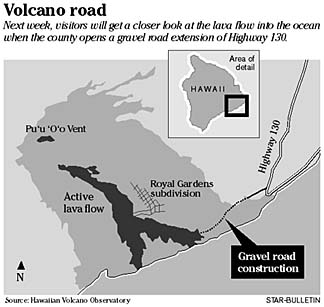


LAVA! HILO >> The glimpses of red lava between breaks in acid-laden steam were brief, but the Big Island's coastal lava flow made a strong impression on Mathias Poser from Potsdam, Germany.
Starting next Friday, Hawaii County
will make it easier to see the flowsSEE ALSO: VOLCANO WATCH
By Rod Thompson
rthompson@starbulletin.comThe stark contrast of colors -- blue ocean, black sand beach, white surf -- all contributed to the impression.
"I have the feeling I'm in another world," Poser said.
By next Friday, if all goes well, many more visitors and local residents will be able to feel the same sense of unearthliness after Hawaii County opens an improved gravel road leading to the spot on the Puna coast where lava is flowing into the sea.
Mayor Harry Kim said the county is making improvements for viewing because lava flowing into the ocean in recent months has shifted from Hawaii Volcanoes National Park to Hawaii County lands.
"It was felt this was good for Hawaii, for the understanding and appreciation of nature's phenomenon," Kim said.

Poser and friend Joerg Shroetter got their view yesterday by hiking to the spot, despite county warnings that not enough safety preparations are in place yet.Late yesterday, county spokeswoman Janet Snyder said access will be closed to both vehicle and foot traffic until Friday, except for the tiny handful of people who still live in the area.
"We don't want a tragedy to occur," she said. "We want this to be a safe viewing program."
A manned roadblock will keep nonresidents out.
Roy Kimoto, a former resident in lava-damaged Royal Gardens subdivision inland from the ocean entry, was one of the hikers to the area yesterday.
"I lived up there for a few months," he said.
He used to watch lava flow downhill near his house.
"It worked on my nerves, so I pulled out," he said.
For a while he hiked four miles to his house from the national park side, sometimes crossing freshly crusted lava flows with red lava still glowing in cracks.
He carried a propane tank for his home on his back.
"It worked on my mind. If I fell through with the propane, blooie!" he said.
John Paul Pai still lives on family land beside the gravel road, sometimes sleeping in a tent, sometimes in his van. He carries in water in jugs from three miles away.
His family used to have about a hundred assorted fruit trees there. Now they are under 15 feet of lava. The Pai family home was the 64th home destroyed by lava on the coast: "Friday the 13th, May 1988," he said.
Pai is not sure how increased traffic will affect him, but he wants people to remember this is his home, even if covered with lava. "It's not a resort area, it's residential," he said.
Fisherman Alfred De Los Santos of Pahoa said the lava entry area is one of the best places to fish because the heat drives small fish out of rocky hiding places. Big fish know that and gather in the area.
But a better road may mean more competition from other fishermen, and he may have to move farther down the coast, he said.
All this is due to a shift in lava patterns.
Arnold Okamura at the Hawaiian Volcano Observatory said lava flows on the coast behave like river water in a delta.
The river mouth swings back and forth across the delta depositing sediment, and lava is shifting back and forth on the Puna coast filling in low spots, he said.
At the moment, the bulk of lava is crossing county land, and the bulk of spectators are crossing county land to see it. On a recent Sunday, Okamura saw a hundred or more people at the site, he said.
Kim said officials came to the conclusion that halting spectators would be impossible, so the county decided to improve the access and try to control their movement.
For several years the county has at least theoretically banned nonresidents from using the rough road bulldozed by residents across the numerous lava flows that have cut through the general area since 1983.
That was to prevent spectators from reaching national park land from county land, Kim said. The outlook has shifted because all the action is now on county land, he said.
The round trip, from the end of pavement to ocean entry and back, is about two miles. One thought is to shuttle people from a parking area to a short coastal trail, Kim said.
Snyder said the county wants to post "guides" along the trail, possibly specially trained local residents.